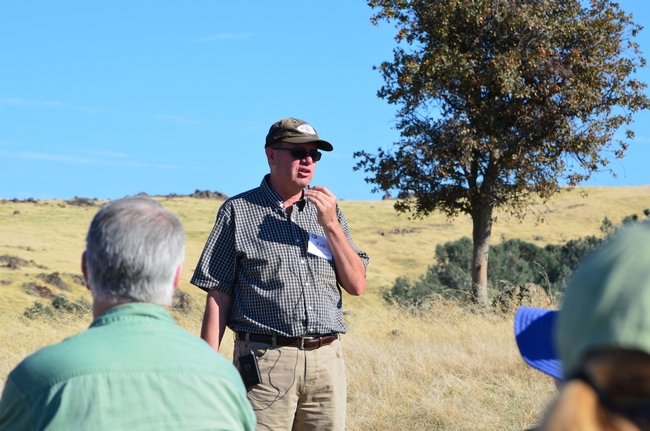
Ecosystem services is a new term I've been hearing. Naturally I wondered, what are these services and is the ecosystem serving me? Ecosystem services are benefits we receive from the environment, such as clean water, open space, beautiful scenery, food production, wildlife habitat and diversity of plants and animals.
Not surprisingly, ecosystem services appeal to a broad audience. However, in the past, many people advocated for a single favored service and would fight with those who were partial to a different service. Now there is a strong trend toward partnerships.
“There’s been sea change on the topic of livestock management and rangeland ecosystem services,” said Ken Tate, UC Cooperative Extension watershed specialist based at UC Davis.
In a scenario 20 years ago, many ranchers would have focused solely on livestock production and ranch profit, while some environmental groups would have voiced concerns solely about wildlife habitat, and a government regulatory agency may have considered water quality the most important service. All parties have begun to recognize the connections among these important services and the need to work together to enhance all of them.
“If a ranch is not economically viable, then there is risk that land could become a shopping mall or some other development,” Tate explained. “A working ranch provides more ecosystem services than developments such as malls or suburban sprawl.”
A UC study published in the current issue of California Agriculture journal found that rangeland owners valued their land for its natural amenities as well as a financial investment.
Recently more than 120 people representing new and long-time ranchers, conservation groups, federal and state natural resources agencies, UC scientists and others gathered for the “Managing Rangeland for Ecosystem Services Workshop and Field Day” to discuss their common goals.
“Interest in this event reflects the growing interest in ecosystem services in a growing number of people,” said Tate, who organized the Oct. 18 event at UC’s Sierra Foothill Research and Extension Center, located 60 miles northeast of Sacramento. “Some people drove four or five hours to attend.”
At the workshop, Tate introduced the Prescribed Grazing for Ecosystem Service Project.

Despite their different backgrounds and ecosystem service priorities, there was no adversarial discussion among the attendees, observed participant Morgan Doran, UC Cooperative Extension livestock & natural resources advisor for Solano County.
“Everyone seemed to be in agreement that livestock are a useful tool in sustaining a healthy rangeland ecosystem,” Doran said. “And all seemed to acknowledge a need to better understand the balance of provisioning goods and services from rangeland systems.”
“We used to talk about one service at a time,” Tate said. “Now we talk about tradeoffs and synergies involved in managing for many services simultaneously. Optimizing water quality might take away from profitability. Talking about tradeoffs used to be confrontational. Now if we can understand the costs of these tradeoffs, there may be an individual or organization willing to pay for that difference. Basically, purchasing ecosystem services.”
Tate credits the workshop cosponsor California Rangeland Conservation Coalition for fostering the collaborative attitude. UC is among the more than 100 agricultural organizations, environmental interest groups, and state and federal agencies that have signed the California Rangeland Resolution, which recognizes that rangelands and the diversity of species they support largely exist due to grazing and other stewardship practices of the ranchers who own and manage the land.
“New people have come to the table who might not have gotten involved in a negative process,” Tate said. “The coalition is a positive approach to the conservation of rangelands, that makes it attractive to people. They are working together to achieve common goals.”
Tate is excited about Cooperative Extension’s role of trying to identify the information needs and conducting the research to supply this information.
Leslie Roche, a UC Davis postdoctoral researcher and presenter, remarked on the interest and enthusiasm in collaborative research and management demonstrated among the diverse group of attendees.
“Everyone is genuinely motivated to work together in bridging the gap between research and management communities on this topic, and that is really exciting," Roche said.
A list of speakers and their presentations for the workshop and field day are posted on the California Rangeland Watershed Laboratory website.
Although the term ecosystem service was unfamiliar to me, it’s not new. In 2000, United Nations Secretary-General Kofi Annan called for the Millennium Ecosystem Assessment. The objective of the project was, “to assess the consequences of ecosystem change for human well-being and the scientific basis for action needed to enhance the conservation and sustainable use of those systems and their contribution to human well-being.”